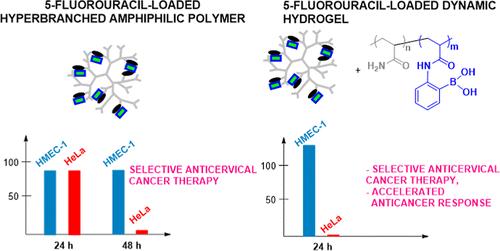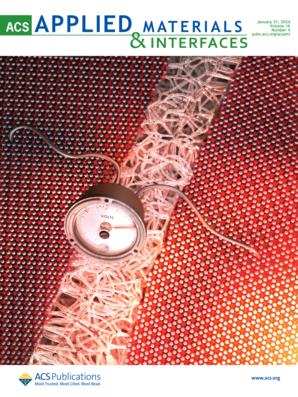Construction of Dynamic Hydrogel Inducing Effective and Selective 5-Fluorouracil Monotherapy against Cervical Cancer Cells
IF 8.2
2区 材料科学
Q1 MATERIALS SCIENCE, MULTIDISCIPLINARY
引用次数: 0
Abstract
The severe side effects of systemic chemotherapy for cervical cancer encourage the use of topical intravaginal drug delivery systems. 5-fluorouracil, 5-FU, is an anticancer drug accepted in clinical use in the cancer therapy of colorectal, gastric, and hepatocellular carcinoma. However, it shows low activity against cervical cancer cells (HeLa) and thus requires the usage of additional drugs to support the therapy, which is associated with side effects. We report on the polyglycidol/polyacrylamide-based hydrogel carrier providing effective monotherapy against cervical cancer cells, HeLa with 5-FU, along with a neutral effect on normal cells, HMEC-1. The use of hyperbranched polyglycidol modified with aryl groups, i.e., phenylurethane, 1,4-biphenylurethane, and benzoyl ester, respectively, to enhance the solubility of 5-FU in the aqueous medium ensured the drug’s efficacy and selectivity against Hela cells after 48 h at a low dose. Crucially, the cross-linking of drug-loaded aryl-enriched polyglycidol with an acrylamide copolymer bearing 2-acrylamidephenylboronic acid induced the anticervical cancer activity reducing the time required for complete cervical cancer cell death to 24 h. An in vitro study showed that boronic acid moieties are responsible for the promotion of anticervical cancer activity with 5-FU. Reported hydrogels’ structure based on reversibly cross-linked aryl-enriched HbPGLs provides the self-healing properties of the network crucial for the formation of the continuous layer of formulation ensuring the delivery of the drug to the afflicted area of the covered tissue. Among tested hydrogels, the system constructed from HbPGL which linear constitutional units were modified with benzoyl ester or and phenylurethane moieties at approximately 45 mol % showed the highest drug permeability through the STRAT-M model membrane. This study demonstrates the direction of the synthetic design of the hydrogel carrier of 5-FU assuring safe monotherapy of cervical cancer cells, avoiding side effects typical for combinatory therapies.

动态水凝胶诱导有效选择性5-氟尿嘧啶单药治疗宫颈癌细胞的构建
宫颈癌全身化疗的严重副作用鼓励使用局部阴道内给药系统。5-氟尿嘧啶(5-FU)是临床公认的用于治疗结直肠癌、胃癌和肝癌的抗癌药物。然而,它对宫颈癌细胞(HeLa)的活性较低,因此需要使用额外的药物来支持治疗,这与副作用有关。我们报道了一种基于聚甘油醇/聚丙烯酰胺的水凝胶载体,它可以有效地单一治疗宫颈癌细胞HeLa和5-FU,同时对正常细胞HMEC-1也有中性作用。采用芳基修饰的超支化聚甘醇,分别为苯基脲、1,4-联苯脲和苯甲酰酯,提高5-FU在水介质中的溶解度,保证了药物在低剂量下48 h后对Hela细胞的有效性和选择性。至关重要的是,载药的富含芳基的聚甘油三酯与含有2-丙烯酰胺苯基硼酸的丙烯酰胺共聚物交联可诱导抗宫颈癌活性,将宫颈癌细胞完全死亡所需的时间缩短至24小时。一项体外研究表明,硼酸部分负责促进5-FU的抗宫颈癌活性。据报道,基于可逆交联芳基富集hbpgl的水凝胶结构提供了网络的自愈特性,这对于形成连续的配方层至关重要,确保将药物输送到覆盖组织的受损区域。在测试的水凝胶中,由线性构成单元被苯甲酰酯和苯脲基团以约45 mol %的浓度修饰的HbPGL构建的体系通过STRAT-M模型膜的药物渗透性最高。本研究为5-FU水凝胶载体的合成设计指明了方向,保证了宫颈癌细胞单药治疗的安全性,避免了联合治疗的副作用。
本文章由计算机程序翻译,如有差异,请以英文原文为准。
求助全文
约1分钟内获得全文
求助全文
来源期刊

ACS Applied Materials & Interfaces
工程技术-材料科学:综合
CiteScore
16.00
自引率
6.30%
发文量
4978
审稿时长
1.8 months
期刊介绍:
ACS Applied Materials & Interfaces is a leading interdisciplinary journal that brings together chemists, engineers, physicists, and biologists to explore the development and utilization of newly-discovered materials and interfacial processes for specific applications. Our journal has experienced remarkable growth since its establishment in 2009, both in terms of the number of articles published and the impact of the research showcased. We are proud to foster a truly global community, with the majority of published articles originating from outside the United States, reflecting the rapid growth of applied research worldwide.
 求助内容:
求助内容: 应助结果提醒方式:
应助结果提醒方式:


